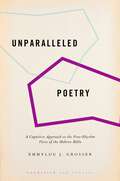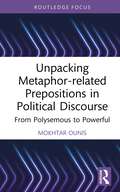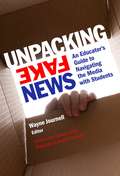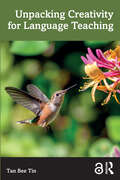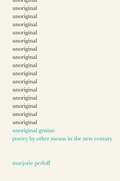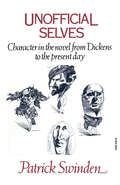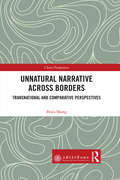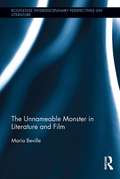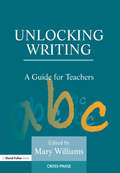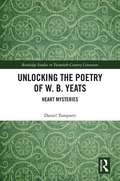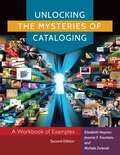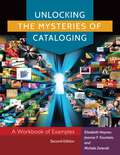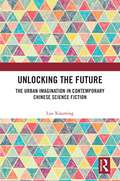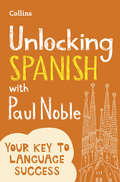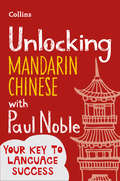- Table View
- List View
Unparalleled Poetry: A Cognitive Approach to the Free-Rhythm Verse of the Hebrew Bible (COGNITION AND POETICS SERIES)
by Emmylou J. GrosserFor more than 250 years, biblical Hebrew poetry scholarship has been dominated by metrical assumptions and the idea of parallelism. While a consensus is emerging that biblical poetry is not metrical, no consensus has arisen regarding what parallelism is, or what makes biblical poetry "verse" or "poetry" in the absence of meter, graphical lineation, and end-marking of lines. Unparalleled Poetry claims that a new paradigm for biblical poetry is needed, a paradigm that is disentangled from parallelism as well as meter. Drawing from the Cognitive Poetics work of Reuven Tsur, Emmylou Grosser reorients the discussion of biblical poetic structure to how poetic structure can be heard and perceived. She argues that the line-units of biblical poetry emerge in the cognitive experience of the listener/reader and provides an account of the free-rhythm versification system of biblical poetry. Grosser's cognitive approach to biblical poetry accounts for the wide diversity of lines and poems in the Bible and illuminates both the structures of biblical poetry and the artistry of potential effects. Unparalleled Poetry presents a rewarding new paradigm for readers of the Bible, while modeling new possibilities for the study of nonmetrical poetries and phenomena called "parallelism" throughout the world.
Unparalleled Poetry: A Cognitive Approach to the Free-Rhythm Verse of the Hebrew Bible (COGNITION AND POETICS SERIES)
by Emmylou J. GrosserFor more than 250 years, biblical Hebrew poetry scholarship has been dominated by metrical assumptions and the idea of parallelism. While a consensus is emerging that biblical poetry is not metrical, no consensus has arisen regarding what parallelism is, or what makes biblical poetry "verse" or "poetry" in the absence of meter, graphical lineation, and end-marking of lines. Unparalleled Poetry claims that a new paradigm for biblical poetry is needed, a paradigm that is disentangled from parallelism as well as meter. Drawing from the Cognitive Poetics work of Reuven Tsur, Emmylou Grosser reorients the discussion of biblical poetic structure to how poetic structure can be heard and perceived. She argues that the line-units of biblical poetry emerge in the cognitive experience of the listener/reader and provides an account of the free-rhythm versification system of biblical poetry. Grosser's cognitive approach to biblical poetry accounts for the wide diversity of lines and poems in the Bible and illuminates both the structures of biblical poetry and the artistry of potential effects. Unparalleled Poetry presents a rewarding new paradigm for readers of the Bible, while modeling new possibilities for the study of nonmetrical poetries and phenomena called "parallelism" throughout the world.
Unpacking Metaphor-related Prepositions in Political Discourse: From Polysemous to Powerful (Routledge Research on New Waves in Pragmatics)
by Mokhtar OunisThis book explores the context around why English prepositions are used in figurative language more frequently than nouns and verbs, using corpus-based evidence to examine the most often used prepositions and how they are employed and for what purpose. While research on cognitive approaches to metaphor has significantly expanded in recent decades, little attention has been paid to prepositions as vehicles of figurative language, owing to their polysemous, complex, and inconsistent nature. To bridge this gap, Ounis introduces an innovative conceptual framework that integrates conceptual metaphor theory, diachronic linguistics, and discourse pragmatics. Drawing upon an extensive corpus of American presidential inaugural addresses, this book considers the linguistic, conceptual, pragmatic, and contextual dimensions of English prepositions, revealing the fascinating interplay between language, culture, and cognition. This volume will be of interest to scholars in pragmatics, metaphor studies, English language, rhetoric studies, and historical linguistics.
Unpacking Metaphor-related Prepositions in Political Discourse: From Polysemous to Powerful (Routledge Research on New Waves in Pragmatics)
by Mokhtar OunisThis book explores the context around why English prepositions are used in figurative language more frequently than nouns and verbs, using corpus-based evidence to examine the most often used prepositions and how they are employed and for what purpose. While research on cognitive approaches to metaphor has significantly expanded in recent decades, little attention has been paid to prepositions as vehicles of figurative language, owing to their polysemous, complex, and inconsistent nature. To bridge this gap, Ounis introduces an innovative conceptual framework that integrates conceptual metaphor theory, diachronic linguistics, and discourse pragmatics. Drawing upon an extensive corpus of American presidential inaugural addresses, this book considers the linguistic, conceptual, pragmatic, and contextual dimensions of English prepositions, revealing the fascinating interplay between language, culture, and cognition. This volume will be of interest to scholars in pragmatics, metaphor studies, English language, rhetoric studies, and historical linguistics.
Unpacking Fake News: An Educator's Guide To Navigating The Media With Students (PDF)
by Wayne Journell Rebecca Klein Jeremy StoddardSince the 2016 presidential election, the term fake news has become part of the national discourse. In this book, leading civic education scholars unpack why fake news is effective and show K-12 educators how they can teach their students to be critical consumers of the political media they encounter.
Unpacking Creativity for Language Teaching
by Tan Bee TinBefore unlocking creativity, we must first unpack what it means. In this book, creativity is unravelled from various perspectives and the relevance for language teaching and learning is explored. Tin offers a coherent discussion of creativity, adopting an inclusive and integrated but, at the same time, focused approach to creativity. Divided into 12 chapters, the book covers: A critical review of the way the term ‘creativity’ is used, defined and written about in various disciplines Various models and theories of creativity, the product- and process-oriented views of creativity and their relevance for language teaching Three pillars on which creative language pedagogy should be based Over 60 practical tasks, applying theoretical arguments and principles of creativity to language teaching and learning Based on the author’s own practice and research on creativity over the last two decades, the book provides exciting new ideas for scholars and practitioners interested in creativity and creative language pedagogy. The book serves as an important contribution for students, teachers and scholars in the field of applied linguistics, language teaching and education.
Unpacking Creativity for Language Teaching
by Tan Bee TinBefore unlocking creativity, we must first unpack what it means. In this book, creativity is unravelled from various perspectives and the relevance for language teaching and learning is explored. Tin offers a coherent discussion of creativity, adopting an inclusive and integrated but, at the same time, focused approach to creativity. Divided into 12 chapters, the book covers: A critical review of the way the term ‘creativity’ is used, defined and written about in various disciplines Various models and theories of creativity, the product- and process-oriented views of creativity and their relevance for language teaching Three pillars on which creative language pedagogy should be based Over 60 practical tasks, applying theoretical arguments and principles of creativity to language teaching and learning Based on the author’s own practice and research on creativity over the last two decades, the book provides exciting new ideas for scholars and practitioners interested in creativity and creative language pedagogy. The book serves as an important contribution for students, teachers and scholars in the field of applied linguistics, language teaching and education.
Unoriginal Genius: Poetry by Other Means in the New Century
by Marjorie PerloffWhat is the place of individual genius in a global world of hyper-information— a world in which, as Walter Benjamin predicted more than seventy years ago, everyone is potentially an author? For poets in such a climate, "originality" begins to take a back seat to what can be done with other people’s words—framing, citing, recycling, and otherwise mediating available words and sentences, and sometimes entire texts. Marjorie Perloff here explores this intriguing development in contemporary poetry: the embrace of "unoriginal" writing. Paradoxically, she argues, such citational and often constraint-based poetry is more accessible and, in a sense, "personal" than was the hermetic poetry of the 1980s and 90s. Perloff traces this poetics of "unoriginal genius" from its paradigmatic work, Benjamin’s encyclopedic Arcades Project, a book largely made up of citations. She discusses the processes of choice, framing, and reconfiguration in the work of Brazilian Concretism and Oulipo, both movements now understood as precursors of such hybrid citational texts as Charles Bernstein’s opera libretto Shadowtime and Susan Howe’s documentary lyric sequence The Midnight. Perloff also finds that the new syncretism extends to language: for example, to the French-Norwegian Caroline Bergvall writing in English and the Japanese Yoko Tawada, in German. Unoriginal Genius concludes with a discussion of Kenneth Goldsmith’s conceptualist book Traffic—a seemingly "pure’" radio transcript of one holiday weekend’s worth of traffic reports. In these instances and many others, Perloff shows us "poetry by other means" of great ingenuity, wit, and complexity.
Unnatural Narrative across Borders: Transnational and Comparative Perspectives (China Perspectives)
by Biwu ShangThis book actively engages with current discussion of narratology, and unnatural narrative theory in particular. Unsatisfied with the hegemony of European and Anglo-American narrative theory, it calls for a transnational and comparative turn in unnatural narrative theory, the purpose of which is to draw readers’ attention to those periphery and marginalized narratives produced in places other than England and America. It places equal weight on theoretical exploration and critical practice. The book, in addition to offering a detailed account of current scholarship of unnatural narratology, examines its core issues and critical debates as well as outlining a set of directions for its future development. To present a counterpart of Western unnatural narrative studies, this book specifically takes a close look at the experimental narratives in China and Iraq either synchronically or diachronically. In doing so, it aims, on the one hand, to show how the unnatural narratives are written and to be explained differently from those Western unnatural narrative works, and on the other hand, to use the particular cases to challenge the existing narratological framework so as to further enrich and supplement it. The book will be useful and inspiring to those scholars working in such broad fields as narrative theory, literary criticism, cultural studies, semiotics, media studies, and comparative literature and world literature studies.
Unnatural Narrative across Borders: Transnational and Comparative Perspectives (China Perspectives)
by Biwu ShangThis book actively engages with current discussion of narratology, and unnatural narrative theory in particular. Unsatisfied with the hegemony of European and Anglo-American narrative theory, it calls for a transnational and comparative turn in unnatural narrative theory, the purpose of which is to draw readers’ attention to those periphery and marginalized narratives produced in places other than England and America. It places equal weight on theoretical exploration and critical practice. The book, in addition to offering a detailed account of current scholarship of unnatural narratology, examines its core issues and critical debates as well as outlining a set of directions for its future development. To present a counterpart of Western unnatural narrative studies, this book specifically takes a close look at the experimental narratives in China and Iraq either synchronically or diachronically. In doing so, it aims, on the one hand, to show how the unnatural narratives are written and to be explained differently from those Western unnatural narrative works, and on the other hand, to use the particular cases to challenge the existing narratological framework so as to further enrich and supplement it. The book will be useful and inspiring to those scholars working in such broad fields as narrative theory, literary criticism, cultural studies, semiotics, media studies, and comparative literature and world literature studies.
The Unnameable Monster in Literature and Film (Routledge Interdisciplinary Perspectives on Literature)
by Maria BevilleThis book visits the 'Thing' in its various manifestations as an unnameable monster in literature and film, reinforcing the idea that the very essence of the monster is its excess and its indeterminacy. Tied primarily to the artistic modes of the gothic, science fiction, and horror, the unnameable monster retains a persistent presence in literary forms as a reminder of the sublime object that exceeds our worst fears. Beville examines various representations of this elusive monster and argues that we must looks at the monster, rather than through it, at ourselves. As such, this book responds to the obsessive manner in which the monsters of literature and culture are ‘managed’ in processes of classification and in claims that they serve a social function by embodying all that is horrible in the human imagination. The book primarily considers literature from the Romantic period to the present, and film that leans toward postmodernism. Incorporating disciplines such as cultural theory, film theory, literary criticism, and continental philosophy, it focuses on that most difficult but interesting quality of the monster, its unnameability, in order to transform and accelerate current readings of not only the monsters of literature and film, but also those that are the focus of contemporary theoretical discussion.
The Unnameable Monster in Literature and Film (Routledge Interdisciplinary Perspectives on Literature)
by Maria BevilleThis book visits the 'Thing' in its various manifestations as an unnameable monster in literature and film, reinforcing the idea that the very essence of the monster is its excess and its indeterminacy. Tied primarily to the artistic modes of the gothic, science fiction, and horror, the unnameable monster retains a persistent presence in literary forms as a reminder of the sublime object that exceeds our worst fears. Beville examines various representations of this elusive monster and argues that we must looks at the monster, rather than through it, at ourselves. As such, this book responds to the obsessive manner in which the monsters of literature and culture are ‘managed’ in processes of classification and in claims that they serve a social function by embodying all that is horrible in the human imagination. The book primarily considers literature from the Romantic period to the present, and film that leans toward postmodernism. Incorporating disciplines such as cultural theory, film theory, literary criticism, and continental philosophy, it focuses on that most difficult but interesting quality of the monster, its unnameability, in order to transform and accelerate current readings of not only the monsters of literature and film, but also those that are the focus of contemporary theoretical discussion.
The Unmaking of the Arab Intellectual: Prophecy, Exile and the Nation (Edinburgh Studies in Modern Arabic Literature)
by Zeina HalabiIn this book Zeina G. Halabi examines the figure of the intellectual as prophet, national icon, and exile in contemporary Arabic literature and film. Staging a comparative dialogue with writers and critics such as Elias Khoury, Edward Said, Jurji Zaidan, and Mahmoud Darwish, Halabi focuses on new articulations of loss, displacement, and memory in works by Rabee Jaber, Elia Suleiman, Rawi Hage, Rashid al-Daif, and Seba al-Herz. She argues that the ambivalence and disillusionment with the role of the intellectual in contemporary representations operate as a productive reclaiming of the ‘political’ in an allegedly apolitical context. The Unmaking of the Arab Intellectual offers the critical tools to understand the evolving relations between the intellectual and power, and the author and the text in the hitherto uncharted contemporary era.
Unlocking Writing: A Guide for Teachers
by Mary WilliamsThe underpinning theme of this book is how children develop as writers and how self-awareness raises achievement. It offers creative approaches to increasing pupil motivation and performance by involving, amongst other things, Drama and ICT. The contributors offer practical advice on ways to meet the needs of boys, able children, SEN pupils and those learning English as an additional language; how to plan effective lessons; how to be flexible within the framework of the NLS; and the role of assessment and how it contributes to self-understanding. Central to all classroom practitioners and students, this innovative book improves general understanding of the process related to composition and transcription and helps to raise the standards of writing in all classrooms.
Unlocking Writing: A Guide for Teachers
by Mary WilliamsThe underpinning theme of this book is how children develop as writers and how self-awareness raises achievement. It offers creative approaches to increasing pupil motivation and performance by involving, amongst other things, Drama and ICT. The contributors offer practical advice on ways to meet the needs of boys, able children, SEN pupils and those learning English as an additional language; how to plan effective lessons; how to be flexible within the framework of the NLS; and the role of assessment and how it contributes to self-understanding. Central to all classroom practitioners and students, this innovative book improves general understanding of the process related to composition and transcription and helps to raise the standards of writing in all classrooms.
Unlocking the Poetry of W. B. Yeats: Heart Mysteries (Routledge Studies in Twentieth-Century Literature)
by Daniel TompsettUnlocking the Poetry of W.B. Yeats undertakes a thorough re-reading of Yeats' oeuvre as an extended meditation on the image and theme of the heart as it is evident within the poetry. It places the heart at the centre of a complex web of Yeatsian preoccupations and associations—from the biographical, to the poetic and philosophical, to the mythological and mystical. In particular, the book seeks to unlock Yeats’ mystifying aesthetic vision via his understanding of the ancient Egyptian "Weighing of the Heart" ceremony. The work provides a chronological narrative arc that looks to use the theme of the heart as it recurs in the poetry in order to circumvent and overcome more established frameworks. Its purpose is to offer refreshing ways of conceptualizing and building alternatives to more deeply entrenched, but not entirely satisfactory arguments that have been offered since Yeats' death in 1939, while demonstrating the centrality of the occult to Yeats' art.
Unlocking the Poetry of W. B. Yeats: Heart Mysteries (Routledge Studies in Twentieth-Century Literature)
by Daniel TompsettUnlocking the Poetry of W.B. Yeats undertakes a thorough re-reading of Yeats' oeuvre as an extended meditation on the image and theme of the heart as it is evident within the poetry. It places the heart at the centre of a complex web of Yeatsian preoccupations and associations—from the biographical, to the poetic and philosophical, to the mythological and mystical. In particular, the book seeks to unlock Yeats’ mystifying aesthetic vision via his understanding of the ancient Egyptian "Weighing of the Heart" ceremony. The work provides a chronological narrative arc that looks to use the theme of the heart as it recurs in the poetry in order to circumvent and overcome more established frameworks. Its purpose is to offer refreshing ways of conceptualizing and building alternatives to more deeply entrenched, but not entirely satisfactory arguments that have been offered since Yeats' death in 1939, while demonstrating the centrality of the occult to Yeats' art.
Unlocking the Mysteries of Cataloging: A Workbook of Examples
by Elizabeth Haynes Joanna F. Fountain Michele ZwierskiIdeal for students and both beginning and practicing catalogers in public, school, and academic libraries, this updated workbook offers targeted, hands-on exercises that enhance understanding of description, classification, subject analysis, subject heading application, and MARC 21 subject analysis.Like the first edition, this updated workbook has a straightforward goal: to help expand and improve the effectiveness of library catalogs. It is designed to supplement existing textbooks by providing exercises in AACR2r and RDA description, classification, subject analysis, and MARC protocols. Particular attention is given to problems that may arise when cataloging books as well as multimedia combinations, 3-D items, toys, natural objects, maps, printed and performed music, bilingual materials, and electronic files. Through the exercises, you will better understand the overall process of cataloging an item and making a record, the application of RDA in producing records, the steps for cataloging new media, and the differences in records using RDA or AACR2r.To enhance the exercises, the workbook incorporates photographs of real materials and offers questions for consideration. There is also a companion website with enlargeable color graphics. The site provides complete answer records and additional indexes for instructors to use in selecting examples for specific elements in the record. For students, new or advanced, selected MARC answer records are included, as are special lists, forms, and indexes leading to the tools any cataloger will need.Student ResourcesExercisesThe images from the exercises in the book are included in this section in a larger format for closer examination. ExercisesMARC TemplateFor use in drafting cataloging records for all types of elements. MARC TemplateInstructor's ResourcesMARC and RDA answer records are provided to instructors upon request. Please contact CustomerService@abc-clio.com for more information.
Unlocking the Mysteries of Cataloging: A Workbook of Examples
by Elizabeth Haynes Joanna F. Fountain Michele ZwierskiIdeal for students and both beginning and practicing catalogers in public, school, and academic libraries, this updated workbook offers targeted, hands-on exercises that enhance understanding of description, classification, subject analysis, subject heading application, and MARC 21 subject analysis.Like the first edition, this updated workbook has a straightforward goal: to help expand and improve the effectiveness of library catalogs. It is designed to supplement existing textbooks by providing exercises in AACR2r and RDA description, classification, subject analysis, and MARC protocols. Particular attention is given to problems that may arise when cataloging books as well as multimedia combinations, 3-D items, toys, natural objects, maps, printed and performed music, bilingual materials, and electronic files. Through the exercises, you will better understand the overall process of cataloging an item and making a record, the application of RDA in producing records, the steps for cataloging new media, and the differences in records using RDA or AACR2r.To enhance the exercises, the workbook incorporates photographs of real materials and offers questions for consideration. There is also a companion website with enlargeable color graphics. The site provides complete answer records and additional indexes for instructors to use in selecting examples for specific elements in the record. For students, new or advanced, selected MARC answer records are included, as are special lists, forms, and indexes leading to the tools any cataloger will need.Student ResourcesExercisesThe images from the exercises in the book are included in this section in a larger format for closer examination. ExercisesMARC TemplateFor use in drafting cataloging records for all types of elements. MARC TemplateInstructor's ResourcesMARC and RDA answer records are provided to instructors upon request. Please contact CustomerService@abc-clio.com for more information.
Unlocking the Future: The Urban Imagination in Contemporary Chinese Science Fiction
by Luo XiaomingThe book highlights the urban imagination in contemporary Chinese science fiction, in order to assess the capacity of Chinese society to conceive of the future. The author argues that ‘the future’ is a set of directional and normative ideas that forms the basis of the entire social mobilization mechanism in China, while the capacity to imagine the future is likely to be produced in response to the present challenges. By discussing the urban space, the reconstruction of time, the infrastructure, and concepts of the urban-rural and civilization in contemporary Chinese science fiction, she demonstrates how contemporary Chinese sci-fi may offer potential solutions to ways of ‘unlocking’ the future. In addition, she also points out the limitations of Chinese society’s imaginative vision of the future. The book will be of interest to scholars and postgraduate students of modern Chinese literature, science fiction studies, urban studies or cultural studies.
Unlocking the Future: The Urban Imagination in Contemporary Chinese Science Fiction
by Luo XiaomingThe book highlights the urban imagination in contemporary Chinese science fiction, in order to assess the capacity of Chinese society to conceive of the future. The author argues that ‘the future’ is a set of directional and normative ideas that forms the basis of the entire social mobilization mechanism in China, while the capacity to imagine the future is likely to be produced in response to the present challenges. By discussing the urban space, the reconstruction of time, the infrastructure, and concepts of the urban-rural and civilization in contemporary Chinese science fiction, she demonstrates how contemporary Chinese sci-fi may offer potential solutions to ways of ‘unlocking’ the future. In addition, she also points out the limitations of Chinese society’s imaginative vision of the future. The book will be of interest to scholars and postgraduate students of modern Chinese literature, science fiction studies, urban studies or cultural studies.
Unlocking Spanish with Paul Noble: Use What You Know Already
by Paul NobleEver tried to learn Spanish and found it too hard? Bestselling language coach Paul Noble has a quick and easy way to get you back on track with his unique tried-and-tested method.
Unlocking Mandarin Chinese with Paul Noble
by Paul Noble Kai-Ti NobleEver tried to learn Mandarin Chinese and found it too hard? Bestselling language coach Paul Noble has a quick and easy way to get you back on track with his unique tried-and-tested method.
